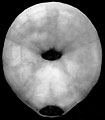The Echinoid Directory
Planilampas Mortensen, 1948, p. 297
| Diagnostic Features |
|
|---|---|
| Distribution | Middle Eocene (Lutetian) to Recent, worldwide distribution. |
| Name gender | feminine |
| Type | Echinolampas sternopatela Agassiz & Clark, 1907, p. 130; by original designation. |
| Species Included |
|
| Classification and/or Status |
|
| Remarks |
|




